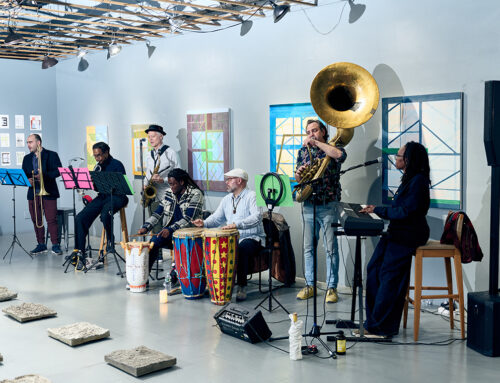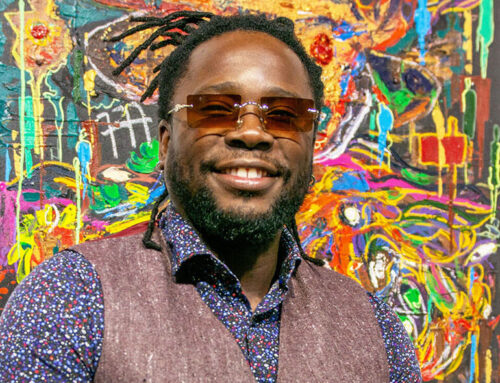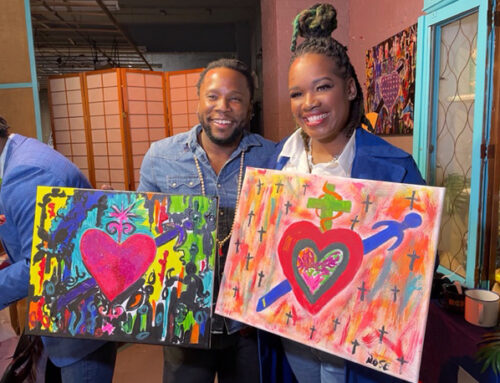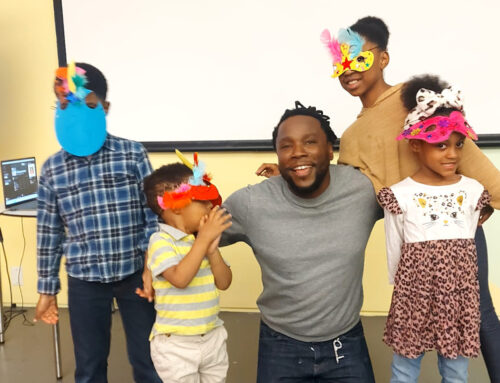On Saturday, December 3, 2022, HCX held the culminating event for 2022 Lakou NOU artists-in-residence at BKLYN Commons. The event showcased visual work by Steven Baboun, live musical performances by Lalin St. Juste and Sherlee Skai, and a video and dance performance choreographed by Robenson Mathurin. Each artist also spoke about their project during a panel discussion moderated by Lakou NOU Coordinators, Sophonie Milande Joseph and Emily Schiffer.

The BKLYN Commons event hall is two stories tall and holds about 200 people. A stage area was created against a wall in the middle of the room, and rows of chairs fanned out in a circle around the stage. String lights zigzagging across the ceiling cast a warm glow across the room. Steven Baboun’s Lakou NOU project, Fanmi M, Men Yo! (“My Family, There They Are!”) , greeted guests as they entered the room. Birthed and inspired by the Haitian queer community and reality, this project celebrates and acknowledges the fluidity of queer Haitians, honoring their ability to imagine and create kind futures for the Haitian queer community in Haiti and around the world. Twelve-foot-high abstract fabric sculptures honoring queer Haitians in history, culture, and our present-day community hung from the ceiling. Illuminated by stage lights in the dimly lit room, these vibrantly colored sculptures captivated viewers. Emanating from each sculpture were sound pieces, created collaboratively with participants in Steven’s Haitian Queer Educational and Artmaking workshops, facilitated during his residency. The audio combined conversation, ethnographic soundscapes and ambient noise from Canarsie into poignant audio portraits. Projected ten feet tall onto the wall behind the stage, were Steven’s photographs of the Haitian community, created at Riva Nyri Précil’s “Fet Èzili”, where many queer Haitians gather to celebrate Haitian Vodou and the freedom of being queer and Haitian. For these photographs, Steven created a custom textile installation as an homage to Èzili Freda, Dantò, and Grann Èzili.
Viewers spent the first hour exploring the artwork and speaking with the artists. Then, Régine M. Roumain, HCX’s founder and Executive Director invited guests to take their seats. She welcomed guests, described the purpose of the Lakou NOU artist residency program, and invited the artists on stage for a panel discussion facilitated by Lakou NOU Coordinators Sophonie Milande Joseph and Emily Schiffer. The artists introduced themselves and their projects, and then the program coordinators asked the following questions: How do you define community engagement in your practice? How does it show up in this project and why is it important? How does your work — both your medium and approach — respond to or challenge established narratives around your topic? What do you want people who engage with this project to take away from it or understand differently? What are your goals? Can you talk about how the topics you cover are intersectional? Why is it important that a Haitian person tell this story? And why is it important to you that the audience tonight is predominantly Haitian?
Watch the full panel discussion on Youtube »
The lights dimmed and Lalin St. Juste’s video Mother Tongue was projected 10 feet tall onto the wall behind the stage. Her 10-minute film combined video of East Flatbush, footage of Haiti, participants family photographs, and video footage of Lalin. These visuals were accompanied by music and audio excerpts of Lalin’s 20 project participants — from East Flatbush — describing their identity, connection to the Haitian language, and how that relationship has been shaped by their environment. The video continued, featuring aerial footage of waves, as Nathalie Guillaume, a musician and dancer, walked slowly through the audience with a thunder drum, making her way to a microphone on stage. She performed a song about Ayiti by Guy Durosier (her great uncle) a cappella. Dressed in a vibrant magenta overcoat, Lalin entered stage right, and a purple spotlight illuminated her as she took her place at an altar, onto which she placed a framed photograph of her maternal grandmother, a glass of water, and a white candle. The two vocalists faced each other and continued singing. On the altar was a soundboard, which Lalin used to incorporate the voices of her participants. She performed original music interpreting and celebrating her complex connection to Kreyòl and her project participants. As Lalin’s voice filled the room, the dancer continued performing around Lalin. The film projection covered both performers, further integrating them into the multidimensional experience. The dancer returned to the microphone with a bell and joined Lalin in song. The performance ended as the two artists connected in a long and heartfelt embrace.
Robenson Mathurin’s work, ‘Koulè M Idantite M (My Skin, My Identity),’ was a dance workshop series that invited Black immigrant Crown Heights community members to express: what does it mean to live, survive, and thrive in your own Black skin? These workshops produced choreography for Robenson’s culminating dance performance, which featured four dance artists and workshop project participants dancing to their audio-recorded testimonies and stories, alongside live Haitian drumming by three skilled percussionists, recorded music, and video projection. The presentation began in a dimmed room with spare but deep colored lighting in yellows and reds. The dancers began with individual solos that grew into three to four dancer deep segments. The dancers’ individual and collective skill in captivating the audience was brought out through the intense choreography of Mathurin. Although the floor space was bare, the choreographer’s skilled use of the space ended with a line of dancers holding the Wakanda symbol to their chest. A call and response gesture that elicited a similar reply from audience members in the form of the same Wakanda gesture and screams of support.
Sherlee Skai’s musical presentation ‘Conversation Through Music’ combined community conversation, storytelling, and acoustic ballads. It was her visual storytelling through the looks that she served that evening which initially captured the audience’s attention as she advocated for her community while acoustically serenading the room. She began the evening’s panel discussion with a coat and blouse combination that set off her makeup as she clearly and passionately articulated the struggles of the Haitian migrants at the US-Mexico border and beyond. Her main look of the evening has been dubbed ‘PoliChic’ green in reference to the singer’s brand of the same name and color scheme. As she sang in the beautiful green dress the communal Lakou NOU vibes in the room continued to grow.
View the full event photo album on Facebook »
—
About the authors
Emily Schiffer is an artist specializing in long-term collaborative art projects which address social issues. She is a Co-founder and Creative Director of We, Women, the largest social impact photography project by women and gender non-conforming artists in the United States. She is a faculty member of the School of Visual Art, and the International Center of Photography. Emily also works as the Lakou NOU Programs Coordinator at HCX, where she supports the artists in residence’s collaborative social justice art projects. To learn more about her work visit www.emilyschiffer.com or wewomenphoto.com.
Sophonie Milande Joseph is a visual artist and community planner. She uses conceptual photography and documentary filmmaking as tools to conduct visual sociology. Sophonie’s commitment to social equity informs a transformative worldview and involvement with grassroots initiatives in Haiti and North America. Her deep passion for justice stems from her background in working with and supporting vulnerable communities over the past decade. Sophonie sits on the board of BlackSpace, a Black urbanist collective of architects, planners, and artists, that strive for environments that recognize, affirm, and amplify Black agency, discourse and thought. To learn more about her work visit www.sofonimjozef.com.







